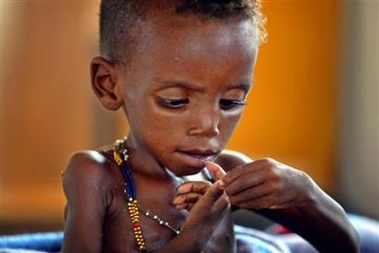|
UN: More hungry in Africa than in '90s
(AP)
Updated: 2005-11-23 09:15
Hunger and malnutrition kill nearly 6 million children a year, and more
people are malnourished in sub-Saharan Africa this decade than in the 1990s,
according to a U.N. report released Tuesday.
Many of the children die from diseases that are treatable, including
diarrhea, pneumonia, malaria and measles, said the report by the Rome-based U.N.
Food and Agriculture Organization.
In sub-Saharan Africa, the number of malnourished people grew to 203.5
million people in 2000-02 from 170.4 million 10 years earlier, the report
states, noting that hunger and malnutrition are among the main causes of
poverty, illiteracy, disease and deaths in developing countries.
The U.N. food agency said the goal of reducing the number of the world's
hungry by half by the year 2015, set by the World Food Summit in 1996 and
reinforced by the Millennium Development Goals in 2000, remains distant but
attainable.
"If each of the developing regions continues to reduce hunger at the current
pace, only South America and the Caribbean will reach the Millennium Development
Goal target," Jacques Diouf, the agency's director-general, wrote in the report,
the agency's annual update on world hunger.
The food agency said the Asia-Pacific region also has a good chance of
reaching the targets "if it can accelerate progress slightly over the next few
years."

A severely malnourished girl is seen in the
town of Tahoua in northwestern Niger, August 2, 2005.
[Reuters] | "Most, if not all of the ... targets
can be reached, but only if efforts are redoubled and refocused," Diouf said.
"To bring the number of hungry people down, priority must be given to rural
areas and to agriculture as the mainstay of rural livelihoods."
U.S. Agriculture Secretary Mike Johanns, on a visit to Rome to meet with FAO
and Italian officials, said Tuesday that free trade and economic growth were key
to fighting hunger.
"We have world goals in terms of reducing hunger, and in terms of long-term
prospects, it really does involve the ability of countries to engage in economic
relationships with each other," he said. "We want economies around the world to
improve, that is really what's going to provide the long term stable base upon
which people are let out of poverty."
Diseases such as AIDS, malaria and tuberculosis, which kill more than 6
million people a year, hit the hungry and poor the hardest, according to the
report's findings. Millions of families are pushed deeper into poverty and
hunger by the illness and death of breadwinners, the cost of health care, paying
for funerals and support of orphans.
About 75 percent of the world's hungry and poor live in rural areas in poor
countries, the report found.
|